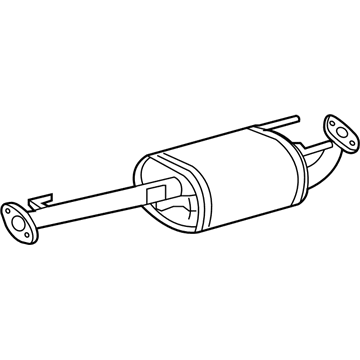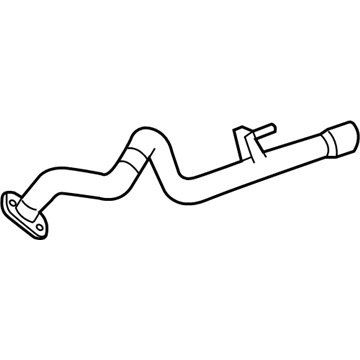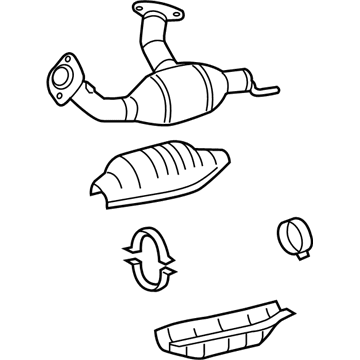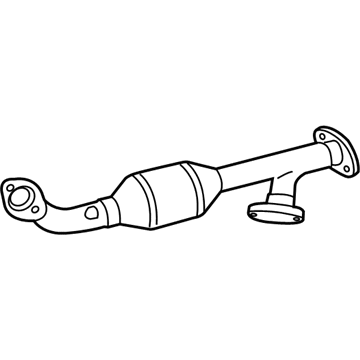×
ToyotaParts- Hello
- Login or Register
- Quick Links
- Live Chat
- Track Order
- Parts Availability
- RMA
- Help Center
- Contact Us
- Shop for
- Toyota Parts
- Scion Parts
My Garage
My Account
Cart
OEM 2007 Toyota FJ Cruiser Exhaust Pipe
Exhaust Tail Pipe- Select Vehicle by Model
- Select Vehicle by VIN
Select Vehicle by Model
orMake
Model
Year
Select Vehicle by VIN
For the most accurate results, select vehicle by your VIN (Vehicle Identification Number).
4 Exhaust Pipes found
2007 Toyota FJ Cruiser Intermediate Pipe, Center
Part Number: 17420-31370$338.65 MSRP: $442.87You Save: $104.22 (24%)Ships in 1-2 Business DaysProduct Specifications- Other Name: Pipe Assembly, Exhaust; Muffler Assembly; Direct-Fit Exhaust; System Kit; Tail Pipe; Muffler & Pipe; Pipe Assembly, Exhaust, Center; Muffler
- Position: Center
- Replaces: 17420-31110
- Part Name Code: 17420
- Item Weight: 1.40 Pounds
- Item Dimensions: 50.9 x 20.2 x 9.3 inches
- Condition: New
- Fitment Type: Direct Replacement
- SKU: 17420-31370
- Warranty: This genuine part is guaranteed by Toyota's factory warranty.
2007 Toyota FJ Cruiser Tail Pipe
Part Number: 17430-30041$207.82 MSRP: $271.78You Save: $63.96 (24%)Ships in 1-2 Business DaysProduct Specifications- Other Name: Pipe Assembly, Exhaust Tail; Exhaust Tail Pipe; Exhaust Pipe; Direct-Fit Exhaust; Exhaust System Kit; Tailpipe; Pipe Assembly, Exhaust, Tail
- Replaces: 17430-30040
- Part Name Code: 17430
- Item Weight: 8.60 Pounds
- Item Dimensions: 45.3 x 12.8 x 9.6 inches
- Condition: New
- Fitment Type: Direct Replacement
- SKU: 17430-30041
- Warranty: This genuine part is guaranteed by Toyota's factory warranty.
2007 Toyota FJ Cruiser Front Pipe, Driver Side
Part Number: 17450-31030$1284.01 MSRP: $1723.52You Save: $439.51 (26%)Ships in 1-3 Business DaysProduct Specifications- Other Name: Pipe Assembly, Exhaust Front; Catalytic Converter, Left, Rear Left; Exhaust Pipe; Converter & Pipe; Pipe Assembly, Exhaust, Front; Catalytic Converter
- Manufacturer Note: *114=TOYOTA/T38/Y
- Position: Front Driver Side
- Part Name Code: 17450B
- Item Weight: 7.30 Pounds
- Item Dimensions: 35.4 x 5.1 x 17.4 inches
- Condition: New
- Fitment Type: Direct Replacement
- SKU: 17450-31030
- Warranty: This genuine part is guaranteed by Toyota's factory warranty.
2007 Toyota FJ Cruiser Front Pipe
Part Number: 17410-31450$1197.53 MSRP: $1607.43You Save: $409.90 (26%)Ships in 1-3 Business DaysProduct Specifications- Other Name: Pipe Assembly, Exhaust; Catalytic Converter, Rear Right, Right; Exhaust Pipe; Converter & Pipe; Pipe Assembly, Exhaust, Front; Catalytic Converter
- Manufacturer Note: *114=TOYOTA/T37/Y
- Position: Front
- Part Name Code: 17410
- Item Weight: 10.00 Pounds
- Item Dimensions: 35.0 x 5.3 x 19.8 inches
- Condition: New
- Fitment Type: Direct Replacement
- SKU: 17410-31450
- Warranty: This genuine part is guaranteed by Toyota's factory warranty.
2007 Toyota FJ Cruiser Exhaust Pipe
Looking for affordable OEM 2007 Toyota FJ Cruiser Exhaust Pipe? Explore our comprehensive catalogue of genuine 2007 Toyota FJ Cruiser Exhaust Pipe. All our parts are covered by the manufacturer's warranty. Plus, our straightforward return policy and speedy delivery service ensure an unparalleled shopping experience. We look forward to your visit!
2007 Toyota FJ Cruiser Exhaust Pipe Parts Q&A
- Q: How to service and repair the exhaust pipe on 2007 Toyota FJ Cruiser?A: The service and repair of an exhaust pipe begins with disconnecting the battery cable and removing the heated oxygen sensor from the vehicle. The first step for tail exhaust pipe assembly service involves removing the 2 bolts that secure the exhaust pipe support before taking out the tail exhaust pipe. The procedure to separate the center exhaust pipe assembly begins with removing the 2 bolts and 2 compression springs which will separate it before the detachment of the 4 exhaust pipe supports allows you to remove the center exhaust pipe. The procedure for the No. 2 front exhaust pipe assembly requires removing two bolts along with an exhaust pipe stopper bracket (if for 4WD) followed by two bolts and two nuts to separate the exhaust pipe support before extracting the No. 2 front exhaust pipe. The front exhaust pipe assembly requires removal of two nuts before separating the front exhaust pipe from the assembly and finally removing the front exhaust pipe gasket. Start the installation process with the front exhaust pipe assembly which requires installation of a new gasket onto the exhaust manifold RH before torquing 2 new nuts to 54 N m (554 kgf cm, 40 ft. lbf). Set a new exhaust pipe gasket on the front exhaust pipe but avoid using the discarded gasket to avoid fitment issues. Secure the gasket in place with wood and plastic-faced hammer before proceeding. Usec the interior manifold LH space to mount a fresh gasket before you secure the No. 2 front exhaust pipe with two new bolts and two new nuts and a new exhaust pipe support by torquing all fasteners to the specified torque values. Two bolts must be used to fasten the exhaust pipe stopper bracket (only for 4WD vehicles) with a torque of 19 N m (193 kgf cm, 14 ft. lbf.). The free length of the compression spring in the center exhaust pipe assembly should be measured with vernier calipers; replacement of the spring is necessary if the measurement falls below 40.5 mm (1.594 in.). Use 2 springs and 2 bolts to fasten the center exhaust pipe onto 4 exhaust pipe supports while conducting a torque to 43 N m (438 kgf cm, 32 ft. lbf.). Place an updated gasket onto the central part of the exhaust pipe before installing the tail exhaust pipe with two bolts and exhaust pipe support using 48 N m (489 kgf cm, 35 ft. lbf.) torque. As the last step insert the heated oxygen sensor and complete the connection to the negative terminal with a torque setting of 3.9 N m (35 in. lbf.) then perform exhaust gas leakage inspection.












